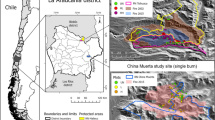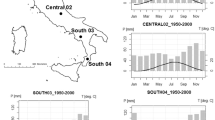Abstract
The study of plant functional types (PFTs) has been widely emphasized when analysing plant community changes in relation to variations in climate and disturbance regime. In this study, we search for PFTs of woody species near forest–grassland boundaries in South Brazil where, due to climate, forests tend to expand over grassland but are being restricted by frequent fires. We aimed at answering the questions: (i) which plant functional types of forest woody species can establish in adjacent grassland subject to fire disturbance and (ii) which plant functional types of forest and grassland woody species are related to short-term community dynamics in frequently burned grassland. Traits were assessed in woody plants in 156 plots (6.75 m2) arranged in 12 transects across forest–grassland boundaries with different fire history in their grassland part. The analysis used a recursive algorithm to search for traits and PFTs maximally associated to spatial distance from forest limit in one analysis, and elapsed time since last fire in another. As a result, nine PFTs of forest woody species were identified that best described community patterns associated to distance from forest. Resprouting ability characterized forest plants able to colonize grasslands. PFT diversity was higher in border plots than inside forest or grassland. Four PFTs of forest and grassland woody species best described woody species community patterns in the grassland associated to elapsed time since fire. Taller individuals of single-stemmed shrubs predominated in late post-fire recovery (3–4 years), while shorter multi-stemmed shrubs in recently burned areas (3 months to 1 year). PFTs of forest trees occurred in border plots or, as established adults, in grassland, remaining unaffected by fire. We conclude that easily measurable structural plant traits, such as those used in our study, are sufficient to evaluate post-fire community dynamics. Forest PFTs in burned grassland are restricted to those with resprouting ability to survive recurrent fire events. Establishment success is highest on protected sites with lesser or low-intensity fire.
Similar content being viewed by others
References
Archibald S, Bond WJ (2003) Growing tall vs growing wide: tree architecture and allometry of Acacia Karroo in forest, savanna, and arid environments. Oikos 102:3–14
Barkman JJ (1988) New systems of plant growth forms and phenological plant types. In: Werger MJA, van der Aart PJM, During HJ, Verhoeven JTA (eds) Plant form and vegetation structure. SPB Academic Publishing, pp 9–44
Behling H (2001) South and southeast Brazilian grasslands during Late Quaternary times: a synthesis. Palaegeogr, Palaeclimatol, Palaeoecol 2710:1–9
Behling H, Pillar VD, Orlóci L, Bauermann SG (2004) Late Quaternary Araucaria forest, grassland (Campos), fire and climate dynamics, studied by high-resolution pollen, charcoal and multivariate analysis of the Cambará do Sul core in southern Brazil. Palaegeogr, Palaeclimatol, Palaeoecol 203:277–297
Bellingham PJ, Sparrow AD (2000) Resprouting as a life history strategy in woody plant communities. Oikos 89:409–416
Bond WJ, Midgley GF (2000) A proposed CO2-controlled mechanism of woody plant invasion in grassland and savannas. Global Change Biol 6:865–869
Bond WJ, Midgley GF (2001) Ecology of sprouting in woody plants: the persistence niche. Trends Ecol Evol 16:45–51
Box EO (1996) Plant functional types and climate at the global scale. J Veg Sci 7:309–320
Brack P, Rodrigues RS, Sobral M, Leite SLC (1998) Árvores e arbustos na vegetação natural de Porto Alegre, Rio Grande do Sul, Brasil, Iheringia. Sér Bot 51:139–166
Bugmann H (1996) Functional types of trees in temperate and boreal forest: classification and testing. J Veg Sci 7:359–370
Campbell BD, Stafford Smith DM, Ash AJ (1999) A rule-based model for the functional analysis of vegetation change in Australasian grasslands. J Veg Sci 10:723–730
Condit R, Hubbell SP, Foster RB (1996) Assessing the response of plant functional types to climatic change in tropical forest. J Veg Sci 7:405–416
Cornelissen JHC, Cerabolini B, Castro-Díey P, Villar-Salvador P, Montserrat-Martí G, Puyravaud JP, Maestro M, Werger MJA, et al (2003) Functional traits of woody plants: correspondence of species rankings between field adults and laboratory-grown seedlings? J Veg Sci 14:311–322
Díaz S, Cabido M (1997) Plant functional types and ecosystem function in relation to global change. J Veg Sci 8:463–474
Díaz S, Cabido M, Zak M, Carretero EM, Araníbar J (1999) Plant functional traits, ecosystem structure and land-use history along a climatic gradient in central-western Argentina. J Veg Sci 10:651–660
Díaz S, Hodgson JG, Thompson K, Cabido M, Cornelissen JHC, Jalili A, Montserrat-Martí G, Grime JP, et al (2004) The plant traits that drive ecosystems: Evidence from three continents. J Veg Sci 15:295–304
Duarte LS, Dos-Santos MG, Hartz SM, Pillar VD (in press). The role of nurse plants on Araucaria forest expansion over grassland in south Brazil. Austral ecology
Eriksson O (2000) Functional roles of remnant plant populations in communities and ecosystems. Global Ecol Biogeogr 9:443–449
Garcia Martinez P (2005) Caracterización química y física de los suelos del Morro Santana (Porto Alegre, Rio Grande do Sul, Brasil). Chair of Soil Sciences, Technische Universität München, Freising-Weihenstephan, Germany
Hoffmann WA, Orthen B, Nascimento PKVd (2003) Comparative fire ecology of tropical savanna and forest trees. Funct Ecol 17:720–726
Langevelde FV, Van de Vijver CADM, Kumar L, Koppel Jvd, Ridder Nd, Andel JV, Skidmore AK, Hearne JW, et al (2003) Effects of fire and herbivory on the stability of savanna ecosystems. Ecology 84:337– 350
Lavorel S, Garnier E (2002) Predicting changes in community composition and ecosystem functioning from plant traits: revisiting the Holy Grail. Funct Ecol 16:545–556
Lavorel S, McIntyre S, Landsberg J, Forbes TDA (1997) Plant functional classification, from general groups to specific groups based on response to disturbance. Trends Ecol Evol 12:474–478
Lloret F, Vilà M (2003) Diversity patterns of plant functional types in relation to fire regime and previous land use in Mediterranean woodlands. J Veg Sci 14:387–398
Müller SC, Forneck ED (2004) Forest–grassland mosaics in the hills of Porto Alegre city: a study case of forest expansion patterns in Santana hill, Rio Grande do Sul, Brazil. In: MLP (ed) Workshop-Proteção e manejo da vegetação natural da região de Porto Alegre, com base em pesquisas de padrões e dinâmica da vegetação. -Programa de Pós-Graduação em Ecologia/UFRGS, pp 29–37
Nimer E (1990) Clima. In: Geografia do Brasil: Região Sul (ed IBGE), pp 151–(187) IBGE
Noble IR, Gitay H (1996) A functional classification for predicting the dynamics of landscapes. J Veg Sci 7:329–336
Overbeck GE, Müller SC, Pfadenhauer J, Pillar VD (2005) Fine-scale post-fire dynamics in southern Brazilian subtropical grassland. J Veg Sci 16:655–664
Pausas JG (1999) Response of plant functional types to changes in the fire regime in Mediterranean ecosystems: a simulation approach. J Veg Sci 10:717–722
Pendergrass KL, Miller PM, Kauffman JB (1998) Prescribed fire and the response of woody species in Willamette Valley wetland prairies. Restor Ecol 6:303–311
Pillar VD (2003) Dinâmica de expansão florestal em mosaicos de floresta e campos no sul do Brasil. In: Cabido M (ed) Ecossistemas brasileiros: manejo e conservação. pp 209–216. Expressão Gráfica e Editora
Pillar VD (2004) SYNCSA software for character-based community analysis, v. 2.2.4. -Departamento de Ecologia, UFRGS
Pillar VD, Orlóci L (1993a) Character-Based Community Analysis; the Theory and an Application Program. SPB Academic Publishing
Pillar VD, Orlóci L (1993b) Taxonomy and perception in vegetation analysis. Coenoses 8:53–66
Pillar VD, Orlóci L (1996) On randomization testing in vegetation science:multifactor comparisons of relevé groups. J Veg Sci 7:582–592
Pillar VD, Quadros FLF (1997) Grassland–forest boundaries in southern Brazil. Coenoses 12:119–126
Pillar VD, Sosinski EE, Jr (2003) An improved method for searching plant functional types by numerical analysis. J Veg Sci 14:323–332
Podani J (2000) Introduction to the exploration of multivariate biological data. Backhuys Publishers
Rambo B (1956) A fisionomia do Rio Grande do Sul. Selbach
Roques KG, O’Connor TG, Watkinson AR (2001) Dynamics of shrub encroachment in an African savanna: relative influences of fire, herbivory, rainfall and density dependence. J Appl Ecol 38:268–280
Sosinski EE, Jr, Pillar VD (2004) Respostas de tipos funcionais de plantas à intensidade de pastejo em vegetação campestre. Pesquisa Agropecuária Brasileira 39:1–9
Teixeira MB, Coura-Neto AB, Pastore U, Rangel Filho ALR (1986) Vegetação. In: Levantamento de recursos naturais. (ed IBGE) pp 541–632. IBGE
Vesk PA, Westoby M (2004) Sprouting ability across diverse disturbances and vegetation types worldwide. J Ecol 92:310–320
Weiher E, van der Werf A, Thompson K, Roderick M, Garnier E, Eriksson O (1999) Challenging Theophrastus: a common core list of plant traits for functional ecology. J Veg Sci 10:609–620
Woodward FI, Cramer W (1996) Plant functional types and climatic changes: introduction. J Veg Sci 7:306–308
Acknowledgments
We would like to thank Enio Sosinski Jr. and Carolina Blanco for discussion and technical assistance and João A. Jarenkow, Marcos Sobral, Ilsi I. Boldrini, Nelson Matzenbacher, and Paulo Brack for their help with species identification. S.M. was supported by a CAPES PhD scholarship and G.O. by a PhD grant from the German National Academic Foundation. V.P. received support from CNPq. The project has been supported by CAPES (Brazil) and DAAD (Germany) under ProBral.
Author information
Authors and Affiliations
Corresponding author
Appendix 1
Appendix 1
Rights and permissions
About this article
Cite this article
Müller, S.C., Overbeck, G.E., Pfadenhauer, J. et al. Plant Functional Types of Woody Species Related to Fire Disturbance in Forest–Grassland Ecotones. Plant Ecol 189, 1–14 (2007). https://doi.org/10.1007/s11258-006-9162-z
Received:
Accepted:
Published:
Issue Date:
DOI: https://doi.org/10.1007/s11258-006-9162-z




